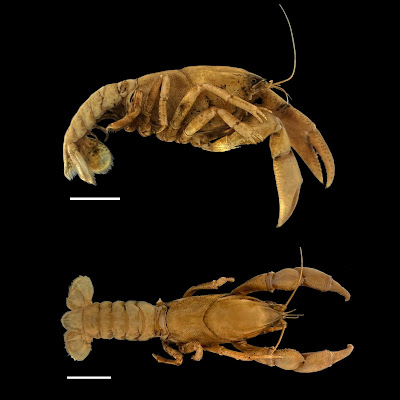 |
| Parastacus longidactylus Huber, Araujo & Ribeiro, 2024 |
Abstract
The present paper describes a new species of freshwater crayfish of the genus Parastacus Huxley, 1879 from the municipality of Amaral Ferrador in the state of Rio Grande do Sul, southern Brazil, evaluates its conservation status according to the IUCN Red List Criteria (sub-criterion B1), and updates the identification key for the genus. Parastacus longidactylus sp. n. differs from all analyzed species by the large eyes, the prominent and wide rostral carinae, surpassing the rostral basis and extending to the proximal third of the postorbital carinae, postorbital carinae and rostral carinae prominent and with similar lengths, chelipeds carpus dorsomedial surface not divided longitudinally by groove and long dactylus, surpassing the fixed finger. The possible extent of occurrence was estimated to be 6,968 km² and the species was recorded in only one location in the Camaquã River basin. The main threats to the region are the replacement of native vegetation by crops and livestock, water pollution and soil erosion. However, because there is only one known location where Parastacus longidactylus sp. n. occurs we suggest classifying the species as Data Deficient.
Keywords: Conservation; crustaceans; Parastacoidea; Rio Grande do Sul; taxonomy
Infraorder Astacidea Latreille, 1802
Superfamily Parastacoidea Huxley, 1879
Family Parastacidae Huxley, 1879
Genus Parastacus Huxley, 1879
 |
| Parastacus longidactylus sp. n., holotype (MZUSP 45071) in ethanol. A, Habitus, dorsal view; B, habitus, lateral view. Scale bar = 10 mm. |
Parastacus longidactylus sp. nov.
Diagnosis. Wide front with short triangular rostrum. Rostral apex shaped as inverted “U”, with straight, blunt spine. Suborbital angle 90°, unarmed. Rostral carinae prominent, wide, surpassing rostral basis, extending to proximal third of postorbital carinae. Postorbital carinae, rostral carinae prominent, with similar length. Cervical groove weakly V-shaped. Areola narrow. Telson subrectangular, longer than wide, with small blunt spines on lateral margins. Mandible with caudal molar process bicuspidate and incisor lobe with 10 teeth. S2 pleurae low and moderate with shallow groove parallel to margin. Chelipeds large and subequal, laterally flattened, with long dactylus surpassing fixed finger. Carpus with dorsomedial surface not divided longitudinally by groove.
Etymology. A combination of the Latin epithets “longus”, which alludes to a long size, and “dactylus”, which alludes to fingers. We suggest the common name “the long-finger crayfish” for this new species.
Augusto Frederico Huber, Paula Beatriz de Araujo and Felipe Bezerra Ribeiro. 2024. A New freshwater Crayfish Species of Parastacus Huxley, 1879 (Malacostraca: Decapoda: Parastacidae) from southern Brazil. Nauplius. 32. DOI: doi.org/10.1590/2358-2936e20230496
